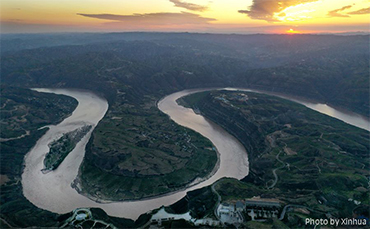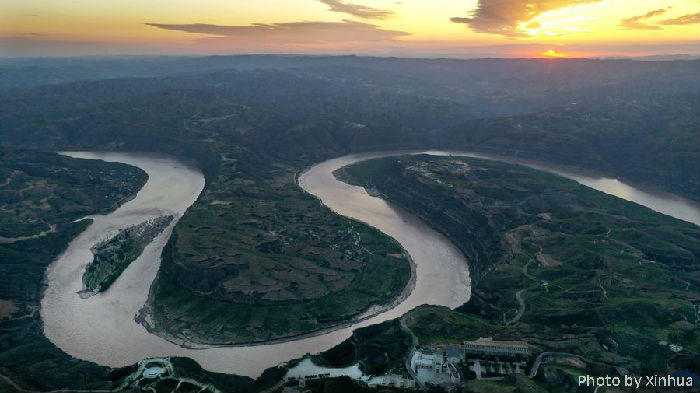



Aerial photo shows the Qiankun Bay of the Yellow River on the border between Yanchuan county, Northwest China's Shaanxi province, and Yonghe county, North China's Shanxi province. [Photo/Xinhua]
The Communist Party of China Central Committee and the State Council have jointly issued a document, titled "Outline of the Yellow River Basin's Ecological Protection and High-quality Development Plan". This outline will guide the country's ecological protection and high-quality development of the Yellow River basin through 2030, and serve as an important basis for formulating and implementing relevant planning schemes, policies and measures, as well as building engineering projects.
The outline has 15 chapters, puts forward 12 major missions to support environmental protection, water conservation, and urban planning along China's second-longest river.
BACKGROUND
The Yellow River is the second-longest river in China, measuring 5,464 km in length, and runs through nine provincial regions, including Qinghai, Sichuan, Gansu, Ningxia, Inner Mongolia, Shanxi, Shaanxi, Henan, and Shandong. The Yellow River basin is an important ecological barrier and is strategically significant for China's national development and modernization.
The scope of the planning covers relevant county-level administrative regions through which the main tributaries of the Yellow River flow, with a land area of about 1.3 million square km and a population of about 160 million at the end of 2019.
"The Yellow River, the mother river of the nation, gave birth to the old Chinese civilization. Its protection is a significant part of the rejuvenation of the nation," says the outline.
GENERAL GUIDANCE
Major Principles
Putting eco-environmental first and pursuing green development. Doing everything within the water capacity and prioritizing water conservation. Making efforts in light of local circumstances and implementing policies on a categorized basis. Exercising cooperated planning and pushing for coordinated protection of the basin.
Development Objectives
By 2030, the relation of humanity and nature will be further improved, and the Yellow River basin’s environment and its water conservation capabilities will have been improved. A paradigm of ecological governance, environmental protection, and urban-rural regional coordinated development will be gradually promoted. A modern flood control and disaster reduction system will be basically built, water resource protection capability will be enhanced, the quality of ecological environment will be significantly improved, the statutes of national food and energy bases will be consolidated, the power system based on urban clusters will be stronger, the rural revitalization will achieve remarkable results, the cultural influence of the Yellow River will be dramatically expanded, the levels of basic pubic services will be increased, and the people living in the basin will be wealthier and happier.
By 2035, ecological protection and high-quality development of the Yellow River basin will make major strategic achievements. The ecological environment of the Yellow River basin will be comprehensively improved and the ecosystem will be healthy and stable. The level of water resource conservation and intense use will be leading nationwide, the modern economic system will be basically established, the Yellow River culture will develop and prosper, and the people’s lives will be improved in all areas. By the middle of this century, new heights will be reached in every dimension of material, political, cultural-ethical, social, and ecological advancement in the Yellow River basin, and these will support China to have developed into a great and modern socialist country that is prosperous, strong, democratic, culturally advanced, harmonious, and beautiful.
Strategic Layouts
Establishing a protection layout of the Yellow River basin, specifically, “one belt, five areas, and multiple places”。 “One belt” refers to the Yellow River ecological belt that connects the Qinghai-Tibet Plateau, the Loess Plateau, the northern sand prevention belts, and the Yellow River Estuary coastal zones. “Five areas” refers to the water supply areas of the Yellow River such as Sanjiangyuan, Qinling Mountains, Qilian Mountain, Liupan Mountain, and Ruoergai (Zoige)。 “Multiple places” refers to the habitats of wild animals and rare vegetation species.
Developing a dynamic pattern of “one axis, two areas, and five poles” in the Yellow River basin, aiming to promote the rational flow and efficient cluster development of factors between regions. “One axis” refers to the modernized economic corridor led by the advanced manufacturing industry and driven by innovation, relying on the international corridor of New Eurasian Land Bridge and connecting the upper, middle, and lower reaches of the Yellow River, as well as the new urban clusters. “Two areas” refers to the dominant grain production area and the energy-rich area. The dominant grain production area includes the North China Plain, the Fenhe-Weihe River Plain, and the Hetao region. The energy-rich area includes Shanxi province and the Ordos basin. “Five poles” refers to the urban clusters such as the Shandong Peninsula cluster, the Central Plains cluster, the Guanzhong Plain cluster, the metropolitan circle of the “Ji” –shaped region, and the Lanzhou-Xining cluster. These clusters are the major carriers of the regional economic development growth poles and the layouts of population and productivity in the basin.
Building a diverse, harmonious, and compatible Yellow River culture display area. The Hehuang-Tibetan and Qiang Cultural Area, mainly including Datong River basin, Huangshui River Basin, Gannan, Ruoergai, Hongyuan, and Shiqu regions, is a fusion area of farming culture and nomadic culture with distinctive ethnic culture characteristics. The Guanzhong Plain Cultural Area, represented by Xi’an, has a time-honored history with plenty of cultural heritage and profound culture. The area includes the middle reach of the Weihe River basin and the Loess Plateau of Shaanxi and Gansu province. The Heluo-Shanxi Cultural Area, which mainly includes the Yiluo River basin and the Fenhe River basin, is the important birthplace of the Chinese nation and has a large number of cultural relics. The Confucian Cultural Area, including the areas of Qufu, Tai’an, etc., has a traditional long history represented by Confucius and Mencius. The Red Cultural Area, such as Shaanxi-Gansu-Ningxia Revolutionary Base and the regions along the Western Route of the Long March, is one of the regions with the largest number of revolutionary sites in China.
Source:
<http://www.news.cn/english/2021-10/08/c_1310232873.htm>
<http://www.gov.cn/zhengce/2021-10/08/content_5641438.htm
Edited and translated by Guo Xinxin